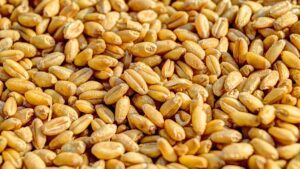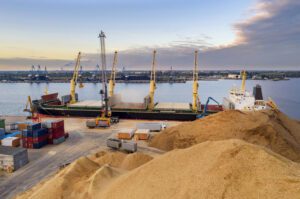
According to the results of January-June 2022, the commissioning of housing in Ukraine has halved compared to the same period in 2021 – to 2 million 420.2 thousand square meters. m, reported the State Statistics Service.
At the same time, it is clarified that the data are given taking into account the housing introduced in accordance with the temporary order of acceptance into operation of buildings built without a construction permit.
According to the report, since the beginning of the year, 1 million 612 thousand square meters have been commissioned in cities. m of housing (66.6% of the total volume), in rural areas – 808.1 thousand square meters. m. At the same time, 46.3% of the total volume of housing was introduced in single-apartment houses, 53.6% – in houses with two or more apartments, 0.1% – in dormitories.
In total, 27,400 apartments were commissioned during the reporting period, which is 54% less than in the first half of 2021. At the same time, 21,200 apartments were built in cities, and 7,100 apartments in villages.
According to the results of the first half of the year, the most housing was introduced in Kyivska (382.3 thousand sq. m, 15.8% of the total volume), Lvivska (305.1 thousand sq. m, 12.6%), Odesa (231.9% ). thousand square meters m, 8.8%), Ivano-Frankivsk (155.3 thousand sq. m, 6.4%) and Zakarpattia (134.3 thousand sq. m, 5.6%) regions and Kyiv (300.5 thousand square meters, 12.4%).
According to statistical data, a reduction in the volume of housing construction was recorded in all regions of Ukraine, except for the Poltava region, where 34.8 percentage points more housing was commissioned than last year (119,000 square meters).
The data are given without taking into account the temporarily occupied territory of Crimea and Sevastopol and part of the temporarily occupied territories in the Donetsk and Luhansk regions, the State Statistics Service reminds.

JSC “Ukrzaliznytsia” (UZ) for the period from August 1 to 23, 2022 exported 1.16 million tons of grain cargo, which is 28% more than in July (917 thousand tons), including through land border crossings 549 thousand tons were transported on the western border (in July – 716 thousand tons), and 467 thousand tons were delivered to the ports (last month – 190 thousand tons).
For 23 days of August, Ukrzaliznytsia loaded 1.16 million tons of grain cargo into wagons, which is 17% of the total loaded volume of 6.9 million tons, such data were announced by Valery Tkachev, Deputy Director of the Department of Commercial Work of UZ, during an online meeting with participants industry on Thursday.
“In March, we had 41.6 thousand tons in export traffic, in July – 917 thousand tons, and for 23 days of August we already have 1.16 million tons. Congratulations to everyone, I already see that we are gradually increasing the volumes transportation, but this is still not enough. Let me remind you that before the war we transported up to 4 million tons in export traffic per month,” Tkachev said during the meeting.
He explained that such an increase in exports to Ukraine was ensured by the Istanbul grain agreements, which unblocked the export of grain cargo from three seaports in the Odessa region in August.
“The share of grain both in terms of loading, and in the delivery of wagons, and in joints is growing. This indicates that farmers quickly adapt to the military situation and begin to load and transport more,” the deputy director commented on the increase in the share of grain cargo to 17% in August from 14% in July.
According to him, for August 1-23, the average daily loading of UZ wagons amounted to 50.2 thousand tons, while earlier this figure was 39-47 thousand tons.
According to Tkachev, since the beginning of August, Ukrzaliznytsia has exported 71,000 tons of sunflower oil, as well as 78,000 tons of cakes and meals of all kinds.
The Deputy Director specified that by August 23, the average daily handling of all types of wagons at border crossings had dipped slightly – to 1.84 thousand wagons from 1.86 thousand wagons in early August, however, the transfer of wagons for grain increased by 12% – to 444 wagons per day against 390 wagons at the beginning of the month.
The UZ representative clarified that the total queue at the crossings as of August 23 amounted to 27.1 thousand cars of all nomenclatures, while at the beginning of the month it was 14% more – 31.5 thousand cars. At the same time, by August 23, there were 8.7 thousand wagons with grain (-12% against the beginning of the month) and 506 wagons with vegetable oil (-41%) in the queue.
“In general, the transfer of wagons at the joints is increasing, the queues with grain are decreasing, while we still have a difficult situation at the Romanian border crossings (Vadul-Siret – Dyakovo), at the Polish border crossing Yagodyn-Dorohusk, where business has actively gone, and the difficult situation remains at Batevo – Epereshke,” Tkachev summed up during the meeting.

The Joint Coordination Centre (JCC) has authorized the movement of five more vessels carrying more than 85,000 tonnes of grain and other food from Ukrainian ports, the UN has reported.
“JCC has authorized the movement of five ships carrying a total of 85,110 tonnes of grain and food under the Black Sea Grain Initiative,” the report says.
The UN said that the Ascanios ship with 58,500 tonnes of corn is destined for Germany, the Mohamad Y ships carrying 11,000 tonnes of wheat and the Bellis carrying 6,000 tonnes of soybeans will travel to Israel. Two more vessels – Oris Sofi and Zelek Star – is transporting 5,900 tonnes of sunflower oil and 3,700 tonnes of peas to Turkey, respectively.
In addition, on Wednesday, the JCC completed the inspection of six vessels following to Ukrainian ports – Canopus, Helga, Lady Zehma, Melina, Michalis and Sealock, as well as three vessels from Ukraine – Kubrosli, Maranta, Great Arsena.
They all were confirmed to sail, the UN said.
The joint inspection teams are scheduled to conduct the following inspections on Thursday: five inbound vessels moving to Ukrainian ports – Golden Yara, Irmgard, Simas, Lady Aillar, Queen Sara, and one outbound vessel – Kafkametler.
“As of August 24, the total tonnage of grain and other foodstuffs exported from three Ukrainian ports is 769,986 tonnes,” the report says.
On July 22, in Istanbul, with the participation of the UN, Ukraine, Turkey and Russia, two documents were signed on the creation of a corridor for the export of grain from three Ukrainian sea trade ports – Chornomorsk, Odesa and Pivdenny.

Ukraine’s pharmaceutical market in the first half of 2022 fell by 27% in volume and 20% in value due to the war compared to the same period last year, the relevant data are given in the report of the SMD company “Ukraine’s pharmaceutical market in the first half 2022. The market in the flames of war.”
At the same time, the company does not provide absolute indicators in the document.
According to the company, the main market drop during this period occurred in April and amounted to 50% in volume and 51% in value compared to April 2021.
At the same time, SMD experts note the significant impact of migration and population decline on the situation in the pharmaceutical market.
At the same time, the company pays attention to some stabilization of the situation in May, as well as to a slight market growth in monetary terms over the past months, which reflects the increase in drug prices.
In addition, the company’s experts emphasize that in the first half of this year, the actual consumption of medicines was higher than the monitoring showed due to the significant amount of humanitarian aid transferred.
At the same time, the share of public procurement was stable in terms of volume – 21% versus 20% in the first half of 2021, but increased from 25% to 30% in value terms due to a larger share of centralized purchases of high-priced products.
In addition, the company notes significant changes in the regional distribution. In particular, the largest reduction in consumption and market share is noted in Kharkiv, Kyiv region (without Kyiv city), as well as in Chernihiv, Kherson, Mykolaiv and Sumy regions.
The largest increase in market share during the war was demonstrated by Lviv region, Kyiv city, Dnipropetrovsk, Ivano-Frankivsk, Volyn, Zakarpattia, Ternopil and other western regions.
At the same time, in Odesa and central regions of Ukraine, there was a slight increase in market share (0.5-0.6%).
“The change in the share of regional markets was influenced not only by internal migration of the population, but also by the work of large military clinics that consumed a significant amount of drugs in certain regions,” the company emphasizes.
Experts also note an increase in the share of domestically produced drugs despite serious damage to some capacities – 38.4% in January-June of this year versus 37% in 2021 as a whole.
According to the study, Sinovac became the leader of the pharmaceutical market during the analyzed period thanks to the purchase of a vaccine against COVID-19.
Without taking this company into account, the position of the market leader, despite a significant reduction in sales, is maintained by Farmak, the second place is taken by the pharmaceutical company Darnitsa, and the third by Yuria-Pharm.
Sanofi and Arterium, respectively, took fourth and fifth positions in the ranking of pharmaceutical market leaders for the first half of the year.

Ukraine and the UK are planning to conclude an agreement on digital trade, which will remove barriers to trade and provide support to Ukrainian businesses, the UK has previously concluded such an agreement only with Singapore, the Ukrainian Ministry of Economy and the Ministry of Digital Transformation report.
The Ministry of Economy in a press release on Wednesday clarified that the day before, First Deputy Prime Minister, Economy Minister Yulia Svyrydenko and Deputy Prime Minister, Minister of Digital Transformation Mykhailo Fedorov discussed this document – Digital Economy Agreement – with Secretary of State for International Trade of Great Britain Anne-Marie Trevelyan.
“The Digital Economy Agreement is a new type of trade agreement that will open up new opportunities for Ukrainian and British businesses through the use of modern technologies that will reduce bureaucratic procedures and promote the use of electronic payments, digital signatures and electronic contracts,” Svyrydenko said.
According to the release of the Ministry of Economy, the agreements involve the creation of digital infrastructure to level restrictions on cross-border data transfer, the opening of a single window for traders and government agencies, the growth of trade in services, proper protection of personal data and improved access to public resources.
The Ministry of Digital Transformation added that among the main areas of cooperation were financial technologies and payment systems, open digital markets and technical cooperation.
The Ministry of Economy clarified that the agreement on digital trade would supplement the agreement on political cooperation, free trade and strategic partnership between Ukraine and the UK, concluded on October 8, 2020.